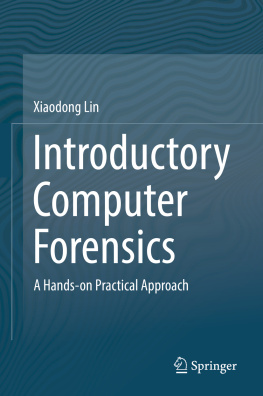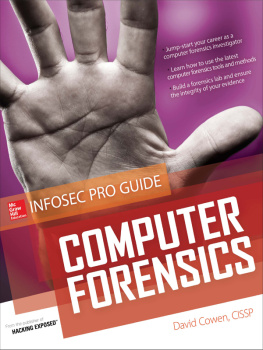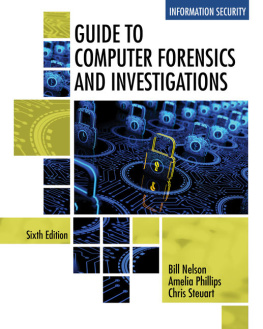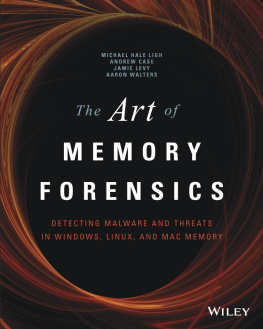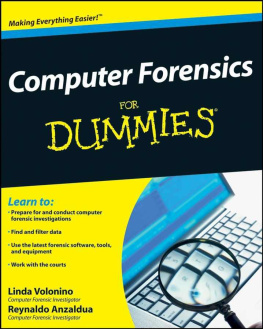Xiaodong Lin - Introductory Computer Forensics
Here you can read online Xiaodong Lin - Introductory Computer Forensics full text of the book (entire story) in english for free. Download pdf and epub, get meaning, cover and reviews about this ebook. year: 0, publisher: Springer International Publishing, genre: Romance novel. Description of the work, (preface) as well as reviews are available. Best literature library LitArk.com created for fans of good reading and offers a wide selection of genres:
Romance novel
Science fiction
Adventure
Detective
Science
History
Home and family
Prose
Art
Politics
Computer
Non-fiction
Religion
Business
Children
Humor
Choose a favorite category and find really read worthwhile books. Enjoy immersion in the world of imagination, feel the emotions of the characters or learn something new for yourself, make an fascinating discovery.
- Book:Introductory Computer Forensics
- Author:
- Publisher:Springer International Publishing
- Genre:
- Year:0
- Rating:3 / 5
- Favourites:Add to favourites
- Your mark:
- 60
- 1
- 2
- 3
- 4
- 5
Introductory Computer Forensics: summary, description and annotation
We offer to read an annotation, description, summary or preface (depends on what the author of the book "Introductory Computer Forensics" wrote himself). If you haven't found the necessary information about the book — write in the comments, we will try to find it.
Introductory Computer Forensics — read online for free the complete book (whole text) full work
Below is the text of the book, divided by pages. System saving the place of the last page read, allows you to conveniently read the book "Introductory Computer Forensics" online for free, without having to search again every time where you left off. Put a bookmark, and you can go to the page where you finished reading at any time.
Font size:
Interval:
Bookmark:
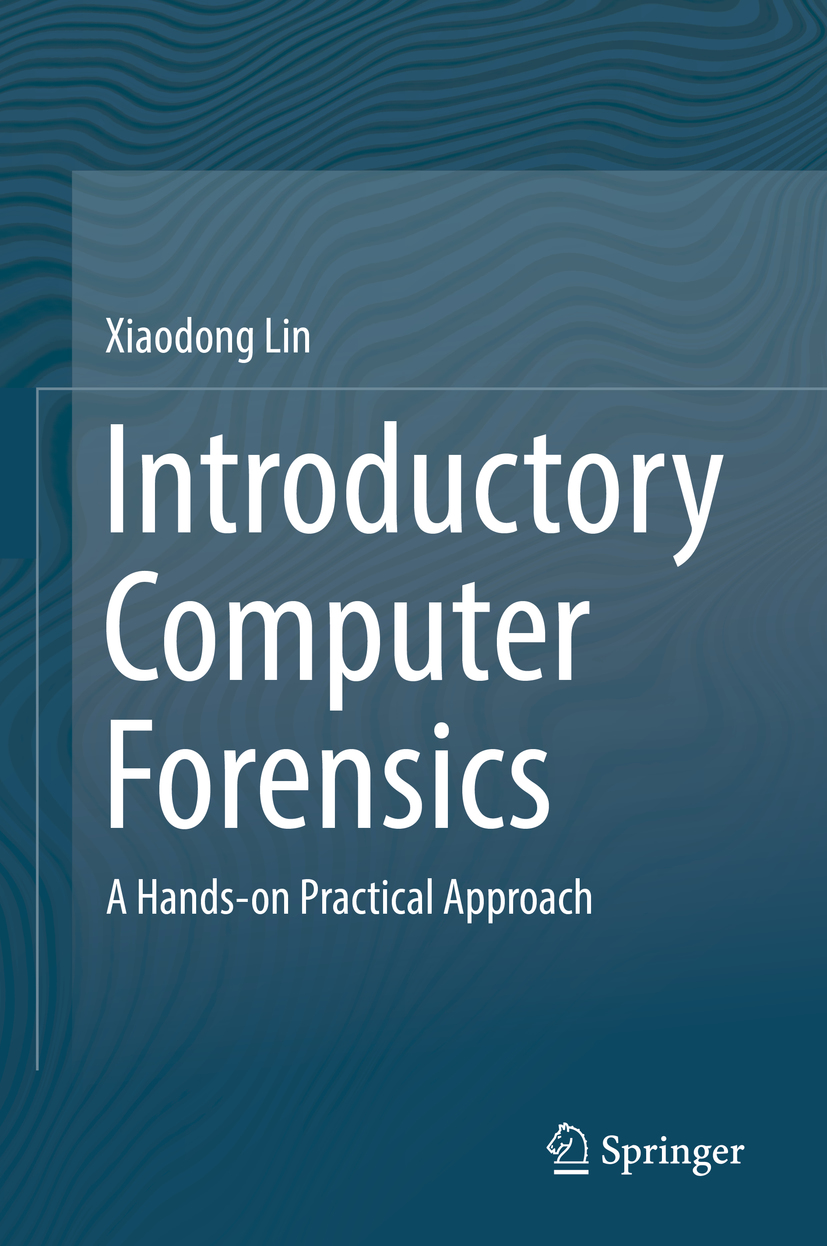

This Springer imprint is published by the registered company Springer Nature Switzerland AG
The registered company address is: Gewerbestrasse 11, 6330 Cham, Switzerland
In deep appreciation and endless memory, this book is dedicated to my dear forever beloved grandmother Xiulin Li who raised me up.
Internet technology is advancing at a speed beyond comprehension. With ever-advancing Internet technology, we truly are living in a digital age. It will certainly improve our quality of life, as it can offer the speed, the capabilities, to handle endless different types of transactions at relatively low cost. Things we take for granted in our daily activities are an excellent example: transferring money, surfing, emailing, sharing information, etc. On the other hand, we will become handicap in our daily life if without Internet. Simply put it, we all depend on the capabilities of Internet technology to run our daily errands more efficiently, even when we do not directly notice it.
Unfortunately, one of Murphys more applicable axioms becomes apparent with this technology: with every solution comes a new set of problems. This marvelous new technology will also provide golden opportunities for organized crime groups, as well as other individuals who want to abuse the technology and maximize their profit illegally. Activities like denial of service attacks, website vandalism, online fraud, money laundering, and more have surfaced. We have all read headlines from around the world about companies being hacked and losing personal information; cybercrimes have become a rampant reality that we must all face, and according to the forecast, the cybercrime trends will worsen globally, and billions of dollars will be lost every year in the global conflict against it.
In order to fight against cybercrime effectively, public prosecutors need to be able to do more than simply match a crime to a suspect; they must be able to produce convincing digital evidence in a court of law, before a judge who may not even know what a USB drive is, in order to put the criminals behind bars. This evidence may include all computer log files, corresponding emails, accounting information, spreadsheets, and other related records, regardless of whether or not these files were deleted or not. According to the study, the majority of digital evidence presented in court is obtainable from all sorts of the daily used electronic devices such as computer, digital camera, BlackBerry, and 3G cell phones.
In one case, former Alaska Governor Sarah Palins e-mail account was hacked by a Tennessee student. After the suspect reset Governor Palins e-mail account password and posted the new password on a forum, the FBI was able to trace the suspects digital footprint or trail, particularly his email address, leading to the suspects apartment. This evidence was vital in helping the federal prosecutor to acquire further necessary digital evidence and arrest the suspect, even while the suspect removed, altered, concealed, and covered up files on his laptop computer.
No individual alone can effectively fight with online criminals, and technology is evolving much faster than the law can adapt. Traditional forensic science, while still invaluable, will not be able to deal with this new wave of cybercrimes. As a result, an exciting new branch of forensic sciencedigital forensicsis emerging.
Digital forensic investigation is a sequence of interdependent and linked procedures, employing technology to study and recreate chains of events that lead to the current state of digital objects. Digital objects may include (but are not limited to) computer systems, such as software applications and databases; data storage devices, such as hard disks, CDs, DVDs, and USB drives; electronic document such as spreadsheets, documents, emails, and images. Digital objects could be as large as an entire network or as small as a single byte. By using technology to examine the digital objects, the investigator can present trustworthy, satisfactory, and legally acceptable evidence to a court of law and provide answers to the questions raised about criminal events.
- (a)
The process of collecting the digital evidence may alter the evidence itself, as it can easily be deleted or altered and become inadmissible to the court; hence, the prosecutor must preserve it in the state it was collected in and provide proof that the digital evidence has not suffered any alteration between the time of collection and the time of admission to the court.
- (b)
As the complexity of digital forensic analysis techniques continues to increase and the size of forensic target grows rapidly, you will experience the need for hundreds of gigabytes, or even terabytes of hard drive space to store all the necessary evidence.
- (c)
As technology is always advancing more quickly than the law can compensate for, there is no shortage of new opportunities for online criminals to take advantage of holes in the legal system and use new technology to perform activities that are clearly immoral; however, technically speaking, these activities may be legal, as the law does not, or there is no law to deal with the new situation/environment created by the new technology and that may become a stumbling block between the prosecutors and the lawyers.
As a new subject, digital forensics is not well known to the general public, but interest in it is booming, as more companies and individuals seek the truth about what has happened to their network infrastructure. Even as a growing number of court cases (civil, criminal, and otherwise) involve digital evidence (or electronic evidence), trained digital forensic professionals are in short supply, and cybercrime can be committed anywhere in the world. It has become essential for universities and colleges to offer digital forensics to their students so that the students are well prepared with the proper tools to fight against cybercrime.
Font size:
Interval:
Bookmark:
Similar books «Introductory Computer Forensics»
Look at similar books to Introductory Computer Forensics. We have selected literature similar in name and meaning in the hope of providing readers with more options to find new, interesting, not yet read works.
Discussion, reviews of the book Introductory Computer Forensics and just readers' own opinions. Leave your comments, write what you think about the work, its meaning or the main characters. Specify what exactly you liked and what you didn't like, and why you think so.

